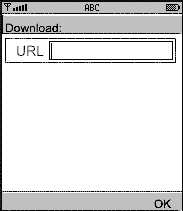
getAllEmailAddresses() method.
It must:
Vector of String
objects that contains the name and email address of all of
the Contact objects in a ContactList
that have a non-empty EMAIL field.
PIM on the device.
public Vector getAllEmailAddresses()
{
ContactList contacts;
Vector result;
try
{
contacts = (ContactList) PIM.getInstance().openPIMList(PIM.CONTACT_LIST,
PIM.READ_WRITE);
}
catch (PIMException e)
{
// An error occurred so return null
}
return result;
}
}
TextField
on a Form that looks something like the following:

TextBox.
Translator class
from the
Sample Questions for the Mid-Term Exam
so that it uses a translation algorithm on another device
(i.e., a translation server).
Copyright 2007